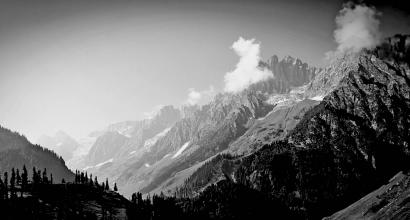ವಸ್ತು
ಎಸ್. ಶಿವಾಜಿ ಜೋಯಿಸ್ ಅವರು ಸಂಪಾದಿಸಿಕೊಟ್ಟಿರುವ ಗೋವಿಂದ ಪೈಗಳ ಸಮಗ್ರ ಕವಿತೆಗಳ ಪ್ರಸ್ತಾವನೆಯನ್ನು ಕಂಡಾಗ ಅಲ್ಲಿ ಸುಮಾರು ನೂರೆಂಬತ್ತು ಕವಿತೆಗಳು ಅಡಕವಾಗಿವೆಯೆಂದು ತಿಳಿಯುತ್ತದೆ; ಇವಲ್ಲದೆ ಮತ್ತೂ ಒಂಬತ್ತು ಅನುಪಲಬ್ಧ ಕವಿತೆಗಳಿದ್ದಂತೆಯೂ ತಿಳಿಯುತ್ತದೆ.[1] ಸದ್ಯದ ಅಧ್ಯಯನವು ಪೂರ್ವೋಕ್ತ ಸಂಗ್ರಹವನ್ನಲ್ಲದೆ ‘ಹೆಬ್ಬೆರಳು’ ಎಂಬ ಏಕಾಂಕನಾಟಕವನ್ನೂ ಸೇರಿಸಿಕೊಂಡಿದೆ. ಇದಕ್ಕೆ ಕಾರಣ ಈ ರೂಪಕದ ಸಂಪೂರ್ಣ ಪದ್ಯಾತ್ಮಕತೆಯೇ. ಆದರೆ ಈ ಅವಲೋಕನದಲ್ಲಿ ಪೈಗಳು ಮಾಡಿದ ಗೀತಾಂಜಲಿಯ ಗದ್ಯಾನುವಾದವಾಗಲಿ, ಅವರ ಇಂಗ್ಲಿಷ್ ಮತ್ತು ಕೊಂಕಣಿ ಕವನಗಳಾಗಲಿ ಪರಿಗಣನೆಗೆ ಬಂದಿಲ್ಲ.
ಇನ್ನುಳಿದ ಎಲ್ಲ ಚಿಕ್ಕ-ದೊಡ್ಡ ಕವಿತೆಗಳ ವಸ್ತುಗಳನ್ನು ಗಮನಿಸಿದರೆ ಸಾಕಷ್ಟು ವೈವಿಧ್ಯವಿರುವುದು ಸ್ಪಷ್ಟವಾಗುತ್ತದೆ. ನವೋದಯದ ಮುಂದಾಳುಗಳಲ್ಲಿ ಒಬ್ಬರಾಗಿದ್ದ ಪೈಗಳು ಆ ಕಾಲದ ಹೆಚ್ಚಿನ ಕವಿಗಳ ಭಾವಗಳನ್ನು ಸ್ಪಂದಿಸುತ್ತಿದ್ದ ಎಲ್ಲ ವಸ್ತುಗಳನ್ನೂ ಪರಾಮರ್ಶಿಸಿದ್ದಾರೆ. ಪುರಾಣ; ಇತಿಹಾಸ; ವರ್ತಮಾನ; ರಾಜಕೀಯ ಮತ್ತು ಸಾಮಾಜಿಕ ಸನ್ನಿವೇಶಗಳು; ವೈದಿಕ, ಜೈನ, ಬೌದ್ಧ ಮತ್ತು ಸೆಮೆಟಿಕ್ ಮೂಲದ ಮತಗಳ ಇತಿವೃತ್ತಗಳು; ದೇಶ-ವಿದೇಶಗಳ ಉದಂತಗಳು; ಬಾನು, ಬುವಿ, ಬೆಟ್ಟ, ಹೊಳೆ, ಕಾಡು ಮತ್ತು ಇವುಗಳ ಅಶೇಷ ಜೀವರಾಶಿಗಳು; ಭಕ್ತಿ, ಅಧ್ಯಾತ್ಮ, ವಿದ್ಯೆ, ವಿಜ್ಞಾನ ಮುಂತಾದ ಚಿಂತನಧಾರೆಗಳು; ವಿಶ್ವಕಲ್ಯಾಣಕ್ಕೆ ದುಡಿದ ದಿವ್ಯಚೇತನರ ಬಾಳುಗಳು; ವೈಯಕ್ತಿಕವಾದ ನೋವು-ನಲಿವುಗಳು (ನೋವಿನ ಪಾಲೇ ಹೆಚ್ಚು) ಮುಂತಾದ ಎಷ್ಟೋ ಸಂಗತಿಗಳು ಪೈಗಳ ಕವಿತೆಗಳಿಗೆ ವಸ್ತುಗಳಾಗಿ, ಇತಿವೃತ್ತಗಳಾಗಿ ಒದಗಿಬಂದಿವೆ. ಇಲ್ಲಿ ಎದ್ದುಕಾಣುವ ಕೆಲವು ಅಂಶಗಳೆಂದರೆ ಮೌಲ್ಯಪ್ರಜ್ಞೆ, ದೇಶಭಕ್ತಿ, ಭಗವದ್ಭಕ್ತಿ, ಪ್ರಕೃತಿಪ್ರೇಮ, ವಿಭೂತಿಪೂಜೆ ಮತ್ತು ಪ್ರೀತಿ-ಸ್ನೇಹ-ಕನಿಕರಗಳಂಥ ಮಾನವೀಯ ಭಾವಗಳ ತೀವ್ರ-ಕೋಮಲ ಸ್ಪಂದನಗಳು.
ಕವಿತೆಯನ್ನು ವಸ್ತುವಿನ್ಯಾಸಕ್ಕೆ ಅನುಗುಣವಾಗಿ ವರ್ಣನಾತ್ಮಕ ಮತ್ತು ಕಥನಾತ್ಮಕ ಎಂದು ಸ್ಥೂಲವಾಗಿ ವಿಭಾಗಿಸಬಹುದು. ಇವೆರಡೂ ಪ್ರಕಾರಗಳಲ್ಲಿ ಪೈಗಳ ಸಾಹಿತ್ಯಕೃಷಿ ಸಾಗಿದೆ; ಬೆಲೆಯುಳ್ಳ ಇಳುವರಿಯನ್ನೂ ತೆಗೆದಿದೆ. ಇಂತಿದ್ದರೂ ಅವರ ಮನೋಧರ್ಮದ ಬೇರಿರುವುದು ಕಥನದಲ್ಲೆಂದು ತೋರುತ್ತದೆ. ದಿಟವೇ, ಅವರ ಕಥನದಲ್ಲಿ ವರ್ಣನೆಗಳು ಕಾಣಿಸಿಕೊಳ್ಳುವ ಹಾಗೆ ವರ್ಣನೆಗಳಲ್ಲಿ ಕಥನವು ಇಣಿಕುವುದಿಲ್ಲ. ಇಂತಿದ್ದರೂ ಕಥನಕ್ಕೆ ಹೆಚ್ಚಿನ ಅವಕಾಶವಿಲ್ಲದ ಕಿರುಗವಿತೆಗಳಲ್ಲಿ ಹಾಗೂ ಸಾನೆಟ್ಟಿನಂಥ ಕಥನಪರಾಙ್ಮುಖ ಬಂಧಗಳಲ್ಲಿ ಕೂಡ ಪೈಗಳು ತಮ್ಮ ಮೂಲಮನೋಧರ್ಮವನ್ನು ವಿಸ್ಮಯಾವಹವಾಗಿ ಮೆರೆಯುತ್ತಾರೆ. ಇದಕ್ಕೆ ಮುಖ್ಯ ಕಾರಣ ಅವರ ಭಾಷಾಪ್ರೌಢಿಮೆ ಮತ್ತು ಅದಕ್ಕಿರುವ ಸಾಂದ್ರೀಕರಣಸಾಮರ್ಥ್ಯ. ಅವರು ಎಂಥ ನಿಡುಗತೆಯನ್ನೂ ನಾಲ್ಕು ಸಾಲುಗಳಲ್ಲಿ ಅಡಕಗೊಳಿಸಬಲ್ಲರು; ಕೆಲವೊಂದು ಘಟನೆಗಳನ್ನಂತೂ ಸಾಲೊಂದರಲ್ಲಿ, ಸಮಾಸವೊಂದರಲ್ಲಿ ಹೇಳಿ ಮುಗಿಸಬಲ್ಲರು! ಈ ಬಗೆಯ ಅಡಕವು ಹಲವೊಮ್ಮೆ ಅರ್ಥಪ್ರತೀತಿಗೆ ತೊಡಕುವುದೂ ಉಂಟು. ಹೀಗೆ ಅಡಕದೊಡನೆ ದುರೂಹ್ಯ ಶಬ್ದಗಳೂ ಸೇರಿಕೊಂಡಾಗ ಅರ್ಥಪ್ರತೀತಿಗೆ ಮತ್ತಷ್ಟು ತೊಡಕಾಗುತ್ತದೆ. ಇಂತಿದ್ದರೂ ಈ ನಿಟ್ಟಿನಲ್ಲಿ ಗೋವಿಂದ ಪೈಗಳ ಸಾಮರ್ಥ್ಯ ಹೆಚ್ಚಿನದು.
ಇನ್ನು ವಸ್ತುವಿಗೆ ಸಂಬಂಧಿಸಿದ ಕೆಲವು ವಿಶಿಷ್ಟ ವಿಷಯಗಳನ್ನು ಗಮನಿಸೋಣ.
ಪೈಗಳು ಪುರಾಣಕಥೆಗಳನ್ನು ಕಾವ್ಯವಸ್ತುವಾಗಿ ಸ್ವೀಕರಿಸುವಾಗ ಯಾವುದೇ ಮತಾಂಧತೆಗೆ ತುತ್ತಾಗದೆ ಆಯಾ ಸಂದರ್ಭದಲ್ಲಿ ಧ್ವನಿತವಾಗುವ ಮಹೋನ್ನತ ಮೌಲ್ಯಪ್ರಜ್ಞೆಯೊಂದನ್ನೇ ನೆಮ್ಮಿ ನಡೆದಿದ್ದಾರೆ. ಜೊತೆಗೆ ಮತಾತೀತವಾಗಿ ಎಲ್ಲ ವಿಭೂತಿಗಳಿಗೆ ತಮ್ಮ ಶ್ರದ್ಧಾ-ಭಕ್ತಿಗಳನ್ನು ಸಲ್ಲಿಸಿದ್ದಾರೆ. ಋಕ್ಸಂಹಿತೆ ಮತ್ತು ಐತರೇಯಬ್ರಾಹ್ಮಣಗಳಲ್ಲಿ ಬರುವ ಕವಷ ಐಲೂಷನೆಂಬ ಶೂದ್ರರ್ಷಿಯನ್ನು ಕುರಿತ ಅವರ ಕವಿತೆ ಸುಪ್ರಸಿದ್ಧ. ಇಲ್ಲಿ ಋಷಿತ್ವವು ಹುಟ್ಟಿಗೆ ಅಧೀನವಲ್ಲವೆಂಬ ಆರ್ಷ ದರ್ಶನವನ್ನು ಮನಮುಟ್ಟುವಂತೆ ನಿರೂಪಿಸಿದ್ದಾರೆ. ಇಡಿಯ ಈ ಕವನದ ನಾಟಕೀಯತೆ ಅದ್ಭುತವಾಗಿದೆ. ಇಲ್ಲಿ ಪೈಗಳು ಬಳಸುವ ಸೋಮಸತ್ರ, ನಿಷದಿಸಿಹನ್, ದಾಸೇಯನ್, ಅದ್ವಿಜನ್, ಅವಿಧೋ, ವರ್ಣಗೇಡಿ ಮುಂತಾದ ಪದಗಳು[2] ವಸ್ತುವಿಗೆ ಅದೆಷ್ಟು ಸುಂದರವಾದ ಆವರಣವನ್ನು ಕಲ್ಪಿಸುತ್ತವೆಂಬುದು ಸ್ವಯಂವೇದ್ಯ.
ಸನಾತನಧರ್ಮದ ಪುರಾಣ-ಇತಿಹಾಸಗಳನ್ನು ಆಧರಿಸಿದ ಕವಿತೆಗಳೂ ಸಾಕಷ್ಟಿವೆ. ಪೈಗಳ ಇಷ್ಟದೇವತೆಯಾದ ಶ್ರೀಕೃಷ್ಣನ ಕೊನೆಯ ದಿನವನ್ನು ಕುರಿತ ಅಪೂರ್ಣ ಖಂಡಕಾವ್ಯ ‘ಪ್ರಭಾಸ’ (ಪು. ೩೯೭) ಇದಕ್ಕೊಂದು ಉಜ್ಜ್ವಲ ನಿದರ್ಶನ. ರಾಮಾಯಣದ ಕ್ರೌಂಚವಧೆಯನ್ನು ಕುರಿತ ‘ಕವಿತಾವತಾರ’ (ಪು. ೩೦) ಕನ್ನಡದ ಮೊದಲ ಸಾನೆಟ್ ಕೂಡ ಹೌದು. ಇಲ್ಲಿ ಕ್ರೌಂಚವಧೆಯ ಪ್ರಸ್ತಾವ ರಸಸಿದ್ಧಿಯ ಮಟ್ಟವನ್ನು ಮುಟ್ಟಿದೆ. ಪೈಗಳ ಮೊದಲಿನ ಕವಿತೆಗಳಲ್ಲಿ ಒಂದಾದ ‘ಕಾಲಿಯಮರ್ದನ’ ವೃತ್ತ-ಕಂದಗಳಲ್ಲಿ ಮೂಡಿದ ಸುಂದರ ರಚನೆ (ಪು. ೨೦೧). ವಿಶೇಷತಃ ಇಲ್ಲಿ ಬರುವ ವಂಶಸ್ಥವೃತ್ತಗಳ ನಾಟ್ಯಾಯಮಾನ ಗತಿ ವಸ್ತುವಿಗೆ ತಕ್ಕ ವ್ಯಂಜಕಸಾಮಗ್ರಿ ಎನಿಸಿದೆ. ಪೈಗಳು ಸರಸ್ವತಿಯನ್ನು ಕುರಿತು ಬರೆದಿರುವ ಪ್ರೌಢೋಜ್ಜ್ವಲವಾದ ಕವಿತೆ ‘ಶ್ರೀಶಾರದಾದೇವಿಗೆ’ (ಪು. ೨೯೬). ಇಲ್ಲಿಯ ವಾಗರ್ಥಸಿದ್ಧಿ ಮೆಚ್ಚುವಂಥದ್ದು. ಈ ರಚನೆಯಲ್ಲಿ ಪೈಗಳು ಸನಾತನಧರ್ಮದ ಶಾರದೆಯನ್ನೂ ಜೈನಾಗಮಗಳ ಸರಸ್ವತಿಯನ್ನೂ ಒಟ್ಟಾಗಿ ಬೆಸೆದಿರುವುದು ಅವರ ಮತೋದಾರತೆಗೆ ಸಾಕ್ಷಿ. ಮಗ ಅಭಿಮನ್ಯುವನ್ನು ಕಳೆದುಕೊಂಡು ಗೋಳಿಡುವ ಸುಭದ್ರೆಯನ್ನು ಕುರಿತ ಆರು ಕಂದಗಳ ‘ಸುಭದ್ರಾವಿಲಾಪ’ (ಪು. ೨೯೦). ಪೈಗಳ ಆರಂಭಿಕ ರಚನೆಗಳಲ್ಲೊಂದು. ಹೀಗೆಯೇ ‘ಭಸ್ಮಾಸುರ’ (ಪು. ೨೪೪) ಮತ್ತು ‘ಶ್ವಪಚನನು ಜತೆಗೊಳದೆ ದಿವಕೇರ್ವೆನೆಂತು?’ ಪುರಾಣಕಥೆಗಳನ್ನು ಆಧರಿಸಿದ ಷೋಡಶಪದಿಗಳು. ಎರಡನೆಯ ಕವಿತೆಯಲ್ಲಿ (ಪು. ೨೬೦) ಹರಿಶ್ಚಂದ್ರನ ಮೌಲ್ಯಪ್ರಜ್ಞೆಯ ಹೊಸತೊಂದು ಆಯಾಮ ಆವಿಷ್ಕೃತವಾಗಿದೆ. ಈ ಪ್ರಕಾರ ಮಗನ ಅಂತ್ಯೇಷ್ಟಿಗೆ ಬಂದ ಪತ್ನಿಯನ್ನು ಕಂಡ ಹರಿಶ್ಚಂದ್ರ ಅಂಥ ದುಃಸ್ಥಿತಿಯಲ್ಲಿಯೂ ಶವದಹನಕ್ಕೆ ತೆರಬೇಕಾದ ಸುಂಕವನ್ನು ಬಿಟ್ಟುಕೊಡಲು ಒಲ್ಲದೆ ಆಕೆಯ ಸೀರೆಯನ್ನೇ ಹರಿದು ಶವವಸ್ತ್ರವಾಗಿ ಬಳಸಲು ಮುಂದಾಗುತ್ತಾನೆ; ಆಗ ಅವನ ಸತ್ಯನಿಷ್ಠೆಯನ್ನು ಮೆಚ್ಚಿದ ಸ್ವರ್ಗ ತನ್ನಲ್ಲಿಗೆ ಅವನನ್ನು ಕರೆಸಿಕೊಳ್ಳಲು ವಿಮಾನವನ್ನು ಕಳುಹಿಸಿಕೊಡುತ್ತದೆ; ಇಂಥ ಪರಿಸ್ಥಿತಿಯಲ್ಲಿಯೂ ಹರಿಶ್ಚಂದ್ರನು ಅದನ್ನೇರಿ ಸ್ವರ್ಗಕ್ಕೆ ಹೋಗಲು ಬಯಸುವುದಿಲ್ಲ; ತನ್ನ ಸ್ವಾಮಿಯಾದ ವೀರಬಾಹುವನ್ನು ಮುಂದಿಟ್ಟುಕೊಳ್ಳದೆ ಈ ಕೆಲಸವನ್ನು ಮಾಡಲು ತಾನು ಸ್ವತಂತ್ರನಲ್ಲವೆಂದು ಸಾರುತ್ತಾನೆ. ಇದು ಪ್ರಾಯಶಃ ಪೈಗಳದೇ ಕಲ್ಪನೆ ಎನಿಸುತ್ತದೆ. ಇಲ್ಲಿ ತೋರಿಕೊಳ್ಳುವ ಹರಿಶ್ಚಂದ್ರನ ಮೌಲ್ಯಪ್ರಜ್ಞೆ ಅನ್ಯತ್ರ ಕಾಣಸಿಗದು. ‘ಎಣ್ಣೆಯ ಬಟ್ಟಲು’ (ಪು. ೧೯೯) ಎಂಬ ಕವಿತೆಯಲ್ಲಿ ಹರಿನಾಮಸಂಕೀರ್ತನೆಯನ್ನು ಮಾಡುವವರ ಪೈಕಿ ತಾನೇ ಮಿಗಿಲೆಂದು ಮೆರೆಯುತ್ತಿದ್ದ ನಾರದನಿಗೆ ಶ್ರೀಹರಿಯು ರಾಮ ಗೌಡನೆಂಬ ಬಡ ರೈತನ ಭಕ್ತಿಯ ಮೂಲಕ ಗರ್ವಭಂಗ ಮಾಡಿದ ಪ್ರಸಂಗವಿದೆ. ಇದು ಪ್ರಸಿದ್ಧ ಪುರಾಣಗಳಲ್ಲಿ ಕಂಡುಬರದಿದ್ದರೂ ಜನಮಾನಸದಲ್ಲಿ ನೆಲೆನಿಂತ ಕಥೆ.
ಸನಾತನಧರ್ಮದ ಶ್ರುತಿ-ಸ್ಮೃತಿ-ಪುರಾಣಾದಿಗಳ ಹಾಗೆಯೇ ಸಂತರೂ ಪೈಗಳ ಸಾಹಿತ್ಯಕ್ಕೆ ಒದಗಿಬಂದಿದ್ದಾರೆ. ವಸ್ತುತಃ ಇವರ ಪ್ರಮಾಣವೇ ಹೆಚ್ಚಿನದು. ವಿದ್ಯಾರಣ್ಯ[3], ಪೊಯ್ಗೆಯ್ಯಾಳ್ವಾರ್ ಪೂದತ್ತಾಳ್ವಾರ್ ಮತ್ತು ಪೇಯಾಳ್ವಾರ್ ಎಂಬ ಶ್ರೀವೈಷ್ಣವ ಸಂತರು[4], ಮಹಾರಾಷ್ಟ್ರದ ಸಂತ ಏಕನಾಥ[5] ಮುಂತಾದ ಸಾಧು-ಸತ್ಪುರುಷರ ಜೊತೆಗೆ ಮೀರಾಬಾಯಿಯಂಥ[6] ಸಾಧ್ವಿಯರನ್ನು ಕುರಿತೂ ಹೃದ್ಯವಾದ ಕವಿತೆಗಳನ್ನು ರಚಿಸಿದ್ದಾರೆ. ಕಡೆಯ ಕವಿತೆಯಲ್ಲಿ ಹೆಣ್ಣಿನ ಮುಖ ನೋಡುವುದಿಲ್ಲ ಎಂಬ ರೂಪಗೋಸ್ವಾಮಿಯ ಪುರುಷಾಹಂಕಾರವನ್ನು ಮಾರ್ಮಿಕವಾಗಿ ತಿರಸ್ಕರಿಸುವ ಮೀರಾಬಾಯಿಯ ವ್ಯಕ್ತಿತ್ವದಲ್ಲಿ ಪೈಗಳ ಕಲ್ಪನೆಯ ಸ್ತ್ರೀವಾದವನ್ನು ಗುರುತಿಸಬಹುದು.
ಇವಿಷ್ಟು ಸನಾತನಧರ್ಮದ ಹಿನ್ನೆಲೆಯ ಕವಿತೆಗಳು. ಜೈನಮತವನ್ನು ಕುರಿತಂತೆ ಇರುವ ಪೈಗಳ ಕವಿತೆಗಳ ಪೈಕಿ ‘ಶ್ರೀ ಗೊಮ್ಮಟ ಜಿನ ಸ್ತುತಿ’ ವಿಶೇಷವಾಗಿದೆ. ಪ್ರಾಯಶಃ ಬೊಪ್ಪಣಕವಿಯ ಜಿನಸ್ತುತಿಯ ಬಳಿಕ ಗೊಮ್ಮಟನನ್ನು ಕುರಿತ ಈ ಪ್ರಮಾಣದ ಅಭಿಜಾತ ಕವಿತೆ ಇದೊಂದೇ. ಇದನ್ನು ಆಧುನಿಕ ವಿಮರ್ಶಕರು ಒಂದು ಪ್ರಗಾಥದಂತೆಯೂ ಕಂಡಿದ್ದಾರೆ. ಇದರ ಮೊದಲ ಪದ್ಯದಲ್ಲಿ ಬರುವ ಎಂಟು ವಿಭಕ್ತಿಗಳ ಪ್ರಸ್ತಾವ ಇಂಥ ಹತ್ತಾರು ಪೂರ್ವಕವಿಪ್ರಯೋಗಗಳ ಮರುಕಳಿಕೆಯೇ ಆಗಿದೆ. ಸಾಂಪ್ರದಾಯಿಕ ವಿದ್ವತ್ತೆ ಮತ್ತು ಆಧುನಿಕ ಸಂವೇದನೆಗಳು ಅದೆಂಥ ಅಭಿಜಾತ ಕವಿತೆಯನ್ನು ಕಂಡರಿಸಬಲ್ಲುವೆಂಬುದಕ್ಕೆ ಈ ಪದ್ಯಮಾಲಿಕೆ ಸಾಕ್ಷಿ. ಬೌದ್ಧ ಮತವನ್ನು ಆಧರಿಸಿ ಹಲವು ಕವಿತೆಗಳು ರೂಪುಗೊಂಡಿವೆ. ಪೈಗಳ ಅಜರಾಮರ ಖಂಡಕಾವ್ಯ ‘ವೈಶಾಖಿ’ಯೂ (ಪು. ೩೬೫) ಸೇರಿದಂತೆ ಹಲವು ಕಥನಕವಿತೆಗಳು ಅವರ ಲೇಖನಿಯಿಂದ ಒಡಮೂಡಿವೆ. ಭಗವಾನ್ ಬುದ್ಧನ ಶಿಷ್ಯ ತಿಷ್ಯನ ಬದುಕಿನ ಘಟನೆಯೊಂದನ್ನು ಆಧರಿಸಿದ ಕವಿತೆ ‘ಭಿಕ್ಷುವೂ ಪಕ್ಷಿಯೂ’ (ಪು. ೨೪೭). ಬುದ್ಧನ ಆಪ್ತ ಶಿಷ್ಯ ಆನಂದನ ಬಾಳಿನ ಘಟನೆಯೊಂದನ್ನು ಆಶ್ರಯಿಸಿದ ಕವಿತೆ ‘ಮಾತಂಗಿ’ (ಪು. ೨೫೩). ಇನ್ನೊಬ್ಬ ಶಿಷ್ಯ ಉಪಗುಪ್ತನ ಬದುಕಿನಲ್ಲಿ ಸುಳಿದ ವಾಸವದತ್ತೆಯೆಂಬ ವೇಶ್ಯೆಯ ಏಳು-ಬೀಳುಗಳನ್ನು ಅವಲಂಬಿಸಿದ ಕವಿತೆ ‘ವಾಸವದತ್ತೆ’ (ಪು. ೨೬೮). ಇವು ಕಥನಕವನಗಳಾಗಿ ಗಣ್ಯತೆ ಗಳಿಸಿವೆ. ಹೆಸರಿಲ್ಲದ ಒಬ್ಬ ಶ್ರಮಣನಂತೆ ಬರುವ ಬುದ್ಧ ಭಗವಂತನ್ನು ಒಳಗೊಂಡಂತೆ ರೂಪುಗೊಂಡ ಕವಿತೆ ‘ಹುಲ್ಲುಕಟಿಗ’ (ಪು. ೨೭೯). ಬೌದ್ಧ ಗ್ರಂಥಗಳ ಪ್ರಕಾರ ಈ ಕಥೆಯಲ್ಲಿ ಬರುವ ಹುಲ್ಲುಕಟಿಗ ಅನ್ನಭರನೇ ಮುಂದೆ ಬುದ್ಧನ ಸೋದರ ಬಂಧುವೂ ಶಿಷ್ಯನೂ ಆದ ಅನುರುದ್ಧ. ಈ ರಚನೆಗಳಲ್ಲೆಲ್ಲ ಪೈಗಳ ಒಳಗಿರುವ ಕತೆಗಾರ ಕಾಣುತ್ತಾನೆ.
ಸೆಮೆಟಿಕ್ ಅಥವಾ ಏಬ್ರಹಾಮಿಕ್ ಮತಗಳಾದ ಕ್ರೈಸ್ತ ಮತ್ತು ಇಸ್ಲಾಮುಗಳನ್ನೂ ಪೈಗಳು ಕಟಾಕ್ಷಿಸಿದ್ದಾರೆ. ಅವರ ಲೋಕಪ್ರಸಿದ್ಧ ಖಂಡಕಾವ್ಯ ‘ಗೊಲ್ಗೊಥಾ’ (ಪು. ೩೪೫) ಕ್ರಿಸ್ತನ ಕೊನೆಯ ದಿನವನ್ನು ಅವಲಂಬಿಸಿದೆ. ತಮ್ಮ ಆರಾಧ್ಯ ದೈವ ಶ್ರೀಕೃಷ್ಣನ ಜೀವನವನ್ನು ಏಸುವಿನ ಬದುಕಿನೊಡನೆ ಬೆಸೆದ ಅಪೂರ್ವ ಕವಿತೆ ‘ಯೇಸು-ಕೃಷ್ಣ’ (ಪು. ೩೮) ಗೇಯರೂಪದಲ್ಲಿದೆ. ಇಲ್ಲಿ ಪಂಪ-ರನ್ನರಂಥ ಪೂರ್ವದ ಕವಿಗಳ ಸ್ಫೂರ್ತಿಯಿಂದ ಪೈಗಳು ಸಮಾಸಕಾವ್ಯದ ರೂಪದಲ್ಲಿ ಇಬ್ಬರ ಬದುಕುಗಳನ್ನೂ ಬಿರುಕಿಲ್ಲದೆ ಬೆಸೆದಿದ್ದಾರೆ. ಇಲ್ಲಿ ಘಟನಾವಳಿಗಳನ್ನು ಹೆಣೆದಿರುವ ಕ್ರಮ ಪೈಗಳ ವೈದುಷ್ಯಕ್ಕೂ ಪ್ರತಿಭೆಗೂ ನಿದರ್ಶನವೆನ್ನಬೇಕು. ಟರ್ಕಿಯ ಮೇಲೆ ದಂಡೆತ್ತಿದ ಇಟಲಿಯ ಅಬ್ಬರವನ್ನು ಕಂಡು ಪೈಗಳು ‘ತುರ್ಕಿಯ ಪರವಾಗಿ ದೇವರೊಡನೆ ಪ್ರಾರ್ಥನೆ’ (ಪು. ೧೮) ಎಂಬ ಕಳಕಳಿಯ ಗೀತವನ್ನು ರಚಿಸಲೂ ಹಿಂದೆಗೆಯುವುದಿಲ್ಲ. ‘ಸುಕ್ಕಿಸದಿರರ್ಧಚಂದ್ರಧ್ವಜವನೊಡೆಯಾ’ ಎಂದು ಮೊರೆಯಿಡುತ್ತಾರೆ! ಹೀಗೆ ಪೈಗಳು ಮತ-ಪುರಾಣ-ಇತಿಹಾಸಗಳ ವಸ್ತುಗಳನ್ನು ನಿಷ್ಕಲ್ಮಷವಾಗಿ ಅವಲಂಬಿಸುತ್ತಾರೆ.
ಪೈಗಳ ಭಗವದ್ಭಕ್ತಿ ಸಾಹಿತ್ಯಲೋಕದಲ್ಲಿ ಸುವಿಶ್ರುತ. ಈವರೆಗೆ ಕಂಡ ಕವಿತೆಗಳಲ್ಲಿಯೂ ಇದು ಪ್ರಸ್ಫುಟವಾಗಿದೆ. ಹೀಗಲ್ಲದೆ ನೇರವಾಗಿ ಭಗವಂತನಿಗೆ ಬಿನ್ನಹ ಸಲ್ಲಿಸುವ ಕವನಗಳೂ ಗೀತಗಳೂ ಬಹಳಷ್ಟಿವೆ. ‘ನಂದಾದೀಪ’ ಎಂಬ ಇಡಿಯ ಕವನಸಂಕಲನ ಇಂಥ ಆತ್ಮನಿವೇದನೆಯಾಗಿದೆ. ಅಳಿದ ಅಕ್ಕರೆಯ ಮಡದಿಯ ವಿಯೋಗವ್ಯಥೆ ಪೈಗಳನ್ನು ಭಗವಂತನಲ್ಲಿ ಶರಣಾಗುವಂತೆ ಮಾಡಿತು; ಆ ಮೂಲಕ ಕರುಣ ಮತ್ತು ವಿಪ್ರಲಂಭಶೃಂಗಾರಗಳು ಆತ್ಮನಿವೇದನೆಯ ಶಾಂತರಸದಲ್ಲಿ ಮುಳುಗುವಂತೆ ಆಯಿತು. ‘ವಿಶ್ವಾಂಜಲಿ’ (ಪು. ೨೪), ‘ಪಂಢರಪುರದಲ್ಲಿ’ (ಪು. ೬೭), ‘ಉಡುಪಿಯಲ್ಲಿ ಶ್ರೀಕೃಷ್ಣ’ (ಪು. ೧೯೮), ‘ಯಶೋದೆಯ ಜೋಗುಳ’ (ಪು. ೨೪೩), ‘ಒಬ್ಬ ಗೋಪಿಯ ವಿಲಾಪ’ (ಪು. ೨೯೩) ಮುಂತಾದ ರಚನೆಗಳು ಗಮನಾರ್ಹ. ಭಗವದ್ಭಕ್ತಿಯ ಇಂಥ ಹೆಚ್ಚಿನ ಭಣಿತಿಗಳು ರಾಗ-ತಾಳಬದ್ಧವಾದ ಗೀತಗಳಾಗಿರುವುದು ಹೆಚ್ಚಿನ ವಿಮರ್ಶಕರ ಅವಧಾನಕ್ಕೆ ಬಂದಂತಿಲ್ಲ. ಇಲ್ಲೆಲ್ಲ ಪೈಗಳು ಕರ್ಣಾಟಕ ಮತ್ತು ಹಿಂದೂಸ್ತಾನಿ ಸಂಗೀತಪದ್ಧತಿಗಳ ರಾಗ-ತಾಳಗಳನ್ನು ಯಥೋಚಿತವಾಗಿ ಸುಚಿಸಿದ್ದಾರೆ. ಈ ಕೆಲವು ರಚನೆಗಳಿಗೆ ಪ್ರೇರಣೆಯಾದ ಧಾಟಿಯ ಹೆಸರನ್ನೂ ಒಕ್ಕಣಿಸಿದ್ದಾರೆ. ಮೂಲತಃ ಗೌಡಸಾರಸ್ವತಸಮುದಾಯಕ್ಕೆ ಸೇರಿದ ಪೈಗಳಿಗೆ ಆ ವಿಪ್ರವರ್ಗದಲ್ಲಿ ಇಂದೂ ವ್ಯಾಪಕವಾಗಿರುವ ಭಜನಸಂಪ್ರದಾಯದ ನೆಲೆಗಟ್ಟು ಗಟ್ಟಿಯಾಗಿತ್ತು. ಹೀಗಾಗಿ ತಾವು ಚಿಕ್ಕಂದಿನಿಂದ ಕೇಳಿ, ಹಾಡಿ ಪರಿಚಿತವಾಗಿದ್ದ ಕೆಲವು ಹಾಡುಗಳನ್ನು ತಮ್ಮ ಗೀತಗಳ ಮಾತೃಕೆಗಳಾಗಿ ಮಾಡಿಕೊಂಡಿದ್ದರೆಂಬುದು ಅಸಂಭಾವ್ಯವಲ್ಲ. ಇದನ್ನು ಹಲವೆಡೆ ಪೈಗಳೇ ಸೂಚಿಸಿದ್ದಾರೆ ಕೂಡ.
ಇನ್ನು ದೇಶಭಕ್ತಿಯನ್ನು ವಸ್ತುವನ್ನಾಗಿ ಉಳ್ಳ ಕವಿತೆಗಳನ್ನು ಕಟಾಕ್ಷಿಸಬಹುದು. ‘ಹಿಂದೂಸ್ತಾನ್ ಹಮಾರಾ’ (ಪು. ೧೧), ‘ಭಾರತ ಭಾಗ್ಯ ವಿಧಾತ’ (ಪು. ೩೧) ಮೊದಲಾದ ಗೀತಗಳಾಗಲಿ, ‘ಭಾರತಾಂಬೆಯ ಮಹಿಮೆ’ (ಪು. ೧೯೪), ‘ಜಯ ಹಿಂದ ಗೀತ’ (ಪು. ೨೦೩), ‘ಹಿಂದುಗಳ ಭಾಗ್ಯವಿನ್ನೆಂದು ನೀ ತೆರೆವೆ?’ (ಪು. ೨೩೫), ‘ಭಾರತಸ್ವಾತಂತ್ರ್ಯದ ಗಾಯತ್ರಿ’ (ಪು. ೨೩೬), ‘ಮನೆವಾರ್ತೆ’ (ಪು. ೨೩೭), ‘ರಾಹುವನು ತೊಲಗಿಸಿದೊ ಕೇತುವನು ತಂದೆ!’ (ಪು. ೨೪೦), ‘ಶ್ರೀಮಾತೃಭೂಮೀಶ್ವರಾಷ್ಟಕ’ (ಪು. ೨೪೧), ‘ಬಿಡುಗಡೆಗೆ’ (ಪು. ೩೧೩), ‘ಭಾರತಧ್ವಜ’ (ಪು. ೩೧೪), ‘ಸ್ವತಂತ್ರ’ (ಪು. ೩೧೭) ಮುಂತಾದ ಹತ್ತಾರು ಕವಿತೆಗಳಾಗಲಿ ಪೈಗಳ ಉಜ್ಜ್ವಲ ರಾಷ್ಟ್ರಭಕ್ತಿಗೆ ದೀಪಸಾಕ್ಷಿಗಳು. ಅವರು ಮೊದಲಿಗೆ ಭಾರತೀಯ; ಬಳಿಕ ಕನ್ನಡಿಗ; ಅನಂತರ ತುಳವ; ಆ ಬಳಿಕ ಕೊಂಕಣಿಗರೂ ಹೌದು. ಈ ಎಲ್ಲ ನೆಲೆಗಳಲ್ಲಿಯೂ ಬಿರುಕಿಲ್ಲದ ಬಾಂಧವ್ಯವನ್ನೂ ಸಾಮರಸ್ಯದ ಸತ್ತ್ವಸೂತ್ರವನ್ನೂ ಕಾಣಿಸಿದ್ದಾರೆ. ಇದಕ್ಕೆ ಸಾಕ್ಷಿಯಾಗಿ ಕನ್ನಡವನ್ನು ಕುರಿತ ಅವರ ಸುಪ್ರಸಿದ್ಧ ಗೀತ ‘ಕನ್ನಡಿಗರ ತಾಯಿ’ (ಪು. ೭೩), ತುಳುನಾಡ ತಾಯನ್ನು ಕುರಿತ ಕವನ ‘ತೌಳವ ಮಾತೆ’ (ಪು. ೪೩), ಕೊಂಕಣಿಗರ ನೆಲೆಯಾಗಿದ್ದ ಗೋವೆಯನ್ನು ಕುರಿತ ಕೊಂಕಣಿ ಕವಿತೆ ‘ಆಮಚೆ‹ ಗೋಮಂತ’ (ಪು. ೪೧೯) ಮುಂತಾದ ರಚನೆಗಳನ್ನು ಪರಿಕಿಸಬಹುದು.
ಪೈಗಳ ನಾಡು-ನುಡಿಗಳ ಭಕ್ತಿ ಈ ನಿಟ್ಟಿನಲ್ಲಿ ದುಡಿದ ರಾಷ್ಟçಕರ ಹಾಗೂ ಕವಿ-ಪಂಡಿತರ ಜೀವನ-ಸಾಧನೆಗಳನ್ನು ಕುರಿತೂ ಕವನಿಸಿದೆ. ಗಾಂಧಿಯವರನ್ನು ಕುರಿತು ಅವರು ಹಲವು ರಚನೆಗಳನ್ನು ಮಾಡಿದ್ದಾರೆ - ‘ಮಹಾತ್ಮರ ಉಪವಾಸ’ (ಪು. ೪೨), ‘ಇನ್ನಿನಿಸು ನೀ ಮಹಾತ್ಮಾ ಬದುಕಬೇಕಿತ್ತು!’ (ಪು. ೧೯೬), ‘ಮಹಾವ್ರತ’ (ಪು. ೨೯೫), ‘ನಿಃಸ್ವ’ (ಪು. ೩೦೭), ‘ವರುಷ ಒಂದಾಯ್ತು’ (ಪು. ೩೧೮), ‘ಸತ್ತು ಗಡ ಬದುಕಿದಿ ಮಹಾತ್ಮ ನೀ ಧನ್ಯ’ (ಪು. ೩೨೩), ‘ಮಹಾತ್ಮನ ಆತ್ಮಕ್ಕೆ’ (ಪು. ೩೨೬), ‘ದೇಹಲಿ’ (ಪು. ೪೦೨). ಈ ಕೆಲವು ರಚನೆಗಳನ್ನು ಕಂಡಾಗ ಗೋವಿಂದ ಪೈಗಳ ಮೇಲೆ ಗಾಂಧಿಯವರ ಪ್ರಭಾವ ಎಷ್ಟು ಗಾಢವಾಗಿತ್ತೆಂದು ತಿಳಿಯುತ್ತದೆ. ವಿಶೇಷತಃ ‘ಮಹಾತ್ಮರ ಉಪವಾಸ’ ಎಂಬ ಕವಿತೆಯಲ್ಲಿ ಗಾಂಧಿಯವರ ಇಪ್ಪತ್ತೊಂದು ದಿವಸದ ಉಪವಾಸಸತ್ಯಾಗ್ರಹದ ಹಿನ್ನೆಲೆಯಾಗಿ ಶುಕ, ಬುದ್ಧ, ಏಸು ಮತ್ತು ಪೈಗಂಬರರ ನಿರಶನವ್ರತಗಳನ್ನು ಪ್ರಸ್ತಾವಿಸುವ ಬಗೆ ಅವರ ಪ್ರತಿಭೆ-ವ್ಯುತ್ಪತ್ತಿಗಳಿಗೆ ಮಾತ್ರವಲ್ಲದೆ ದರ್ಶನಕ್ಕೂ ನಿದರ್ಶನವೆನ್ನಬೇಕು.
ವಿದ್ಯಾರಣ್ಯ, ಕುಮಾರವ್ಯಾಸ ಮತ್ತು ರನ್ನರನ್ನು ಕುರಿತು ಕೂಡ ಪೈಗಳು ಉಜ್ಜ್ವಲವಾದ ಕವಿತೆಗಳನ್ನು ನಿರ್ಮಿಸಿದ್ದಾರೆ - ‘ಶ್ರೀವಿದ್ಯಾರಣ್ಯರ ಅಡಿದಾವರೆಯಲ್ಲಿ’ (ಪು. ೪೭), ‘ಮಹಾಕವಿ ಕುಮಾರವ್ಯಾಸನಿಗೆ’ (ಪು. ೪೬), ‘ರನ್ನ ಮಹಾಕವಿಗೆ’ (ಪು. ೨೯೮) ಇವು ಕ್ರಮವಾಗಿ ಹಳಗನ್ನಡ, ನಡುಗನ್ನಡ ಮತ್ತು ಹಳಗನ್ನಡಗಳ ಜಾಡಿನಲ್ಲಿರುವ ವೃತ್ತ, ಷಟ್ಪದಿ ಮತ್ತು ವೃತ್ತಗಳ ಪ್ರೌಢ ರಚನೆಗಳು. ವಿದ್ಯಾರಣ್ಯರನ್ನು ಕುರಿತು ಬರೆಯುವಾಗ ಅವರ ಬ್ರಾಹ್ಮ-ಕ್ಷಾತ್ತ್ರಸಮಾಯೋಗದ ರಾಜ್ಯಕ ಮತ್ತು ಸಾಹಿತ್ಯಕ ಸಿದ್ಧಿಗಳನ್ನು ಭಾವೋತ್ಕಟತೆಯಿಂದ ಕೊಂಡಾಡುತ್ತಾರೆ. ಕುಮಾರವ್ಯಾಸ ಮತ್ತು ರನ್ನರನ್ನಂತೂ ಅವರು ಬಳಸಿದ ಭಾಷೆ-ಶೈಲಿಗಳ ಮೂಲಕವೇ ಅಭಿನಂದಿಸುತ್ತಾರೆ, ಅಭಿವಂದಿಸುತ್ತಾರೆ. ಇಲ್ಲೆಲ್ಲ ಆಯಾ ವ್ಯಕ್ತಿಗಳನ್ನು ಸಂಬೋಧಿಸುತ್ತ ಕವನಿಸುವ ಪರಿ ಪ್ರಗಾಥಗಳ ಜಾಡನ್ನು ಅನುಸರಿಸುವಂತೆ ತೋರುತ್ತದೆ. ಇವರನ್ನು ಕುರಿತು ನಮ್ಮ ನುಡಿಯಲ್ಲಿ ಇವಕ್ಕಿಂತ ಸೊಗಸಾದ ಕವಿತೆಗಳು ಬಂದಿಲ್ಲವೆಂದರೆ ಅತಿಶಯವಲ್ಲ.
[1] ಗೋವಿಂದ ಪೈ ಸಮಗ್ರ ಕವಿತೆಗಳು, ಪು. ೨೮-೨೯ (ಪ್ರಸ್ತಾವನೆ)
[2] ‘ಶೂದ್ರರ್ಷಿ ಕವಷ’, ಪು. ೨೬೨-೬೩
[3] ‘ಶ್ರೀ ವಿದ್ಯಾರಣ್ಯರ ಅಡಿದಾವರೆಯಲ್ಲಿ’. ಪು. ೪೭
[4] ‘ತುರೀಯ’, ಪು. ೨೨೮
[5] ‘ಏಕನಾಥನೂ ಕತ್ತೆಯೂ’, ಪು. ೩೨೫
[6] ‘ಹೆಂಗಸು’, ಪು. ೮೩
To be continued.










































